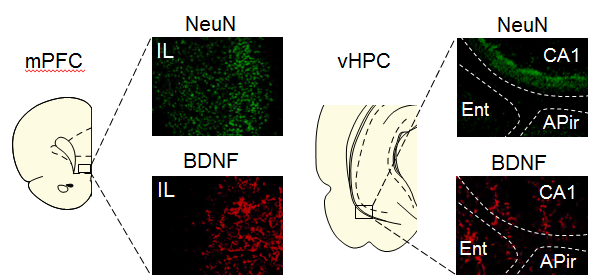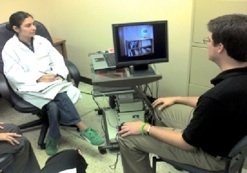Immunocytochemistry and other Molecular Techniques
Auditory Fear Conditioning
We use auditory fear conditioning in which a tone is paired with a mild foot shock. Rats acquire learned fear responses to the tone as indicated by freezing and suppression of bar pressing for food. Subsequently, fear responses are extinguished with tone-alone trials. The following day, memory for fear extinction is assessed.
Platform-mediated Avoidance
We have modified the auditory fear conditioning task to study a type of active avoidance, in which rats avoid a tone-signaled foot-shock by stepping onto a nearby platform. Rats first acquire the tone-shock association, which is then followed by avoidance learning. After ten days of platform avoidance training, freezing to the tone decreases as avoidance increases. This task facilitates the comparison of the effects of manipulations on avoidance versus freezing, and resembles the appetitive “cost” of avoidance behaviors in humans.
Optogenetics in Behaving Rats
We infuse adeno-associated viruses that express Channelrhodopsin (Channel, excitation), Halorhodopsin (Halo, inhibition), or Archaerhodopsin (Arch, inhibition) into specific regions of the rat brain necessary for either fear or avoidance behaviors. Once expressed, these opsins can be activated by laser light delivered through optical fibers. Optogenetics offers important advantages over pharmacological manipulations including cell type specificity, timing specificity, and manipulation limited to terminals. Using this technique, we have found that IL is necessary for extinction learning but not retrieval, 2) circuits of fear retrieval shift with the passage of time, 3) expression of active avoidance requires timed activity in PL neurons, and 4) cue-signaled food seeking is modulated by thalamic projections to the ventral striatum.
Single-Unit Recording from Behaving Rats
We use single-unit recording to monitor neuronal activity in two mPFC subregions, the prelimbic (PL) and infralimbic (IL) cortices, during fear and avoidance behaviors. Our findings show that IL neurons signal extinction memory, whereas PL is responsible for sustaining fear responses after conditioning. We have also combined single-unit recording with localized pharmacological inactivation during fear extinction and have found that pharmacological inactivation of the ventral hippocampus gates fear expression which also correlated with a decrease in neuronal firing in the prelimbic cortex. Ongoing experiments include single unit recording in mPFC subregions during the platform-mediated avoidance task, and ensemble analysis of PL units across time following fear conditioning.
Immunocytochemistry and other Molecular Techniques
We perform immunocytochemical labeling of markers for neuronal activity (c-Fos) and markers of cellular plasticity (p-ERK) to identify structures that signal extinction of fear and avoidance. Combining cFos labeling with retrograde tracers such as cholera toxin-B, we can identify specific circuits that are activated by fear and avoidance behaviors.

Fear Reactions of Monkeys in the Wild
A small island off the south coast of Puerto Rico, Cayo Santiago, is a NIH funded Rhesus Macaque research facility containing 1,000 wild (free roaming) monkeys. We are currently studying fear reactions in these monkeys by exposing them to a rubber snake, and correlating their fear responses with parameters such as age, sex, social behaviors, and genetic markers.

Human Fear Conditioning & Extinction
In collaboration with Dr. Karen G. Martinez’s lab, we use a differential fear conditioning paradigm in humans where subjects view pictures of different rooms (contexts) containing a variable colored light (cue). One color is paired with a mild electric shock (unconditioned stimulus) to their fingers (CS+), whereas a different color is not (CS−). The US delivery occurs at CS+ offset. We use skin conductance responses (SCRs) as our measure of the conditioned fear response. We are examining the correlation of learned fear responses with ethnicity, neuropsychological tests, beta-blockers, and genetic markers (SNPs). We study healthy volunteers as well as individuals with anxiety disorders. CETMA

Computational Modeling of Fear Circuits In collaboration:
In collaboration with Dr. Satish S. Nair at the University of Missouri, we us computational modeling to test hypothesis about prefrontal-amygdala circuits that regulate fear responses following conditioning and extinction. Combining biologically realistic Hodgkin-Huxley-type modeling with actual unit recording, we can test novel hypotheses generated by the model about circuits of conditioned fear and avoidance.
